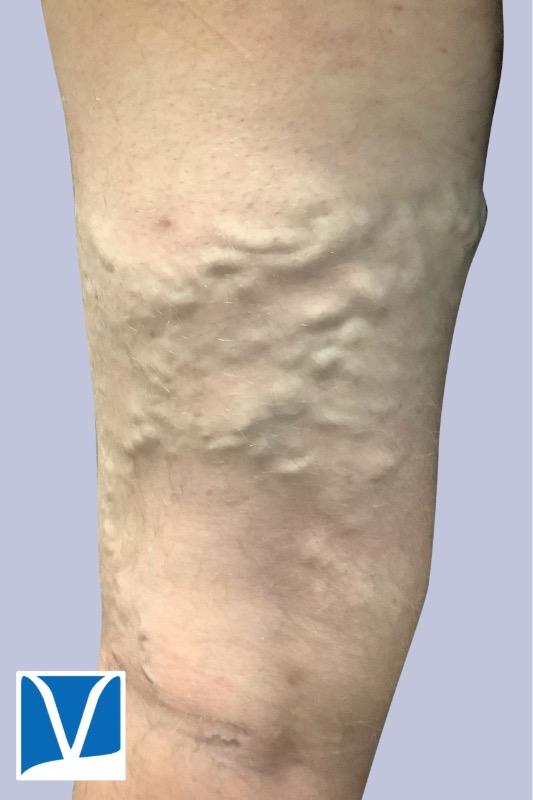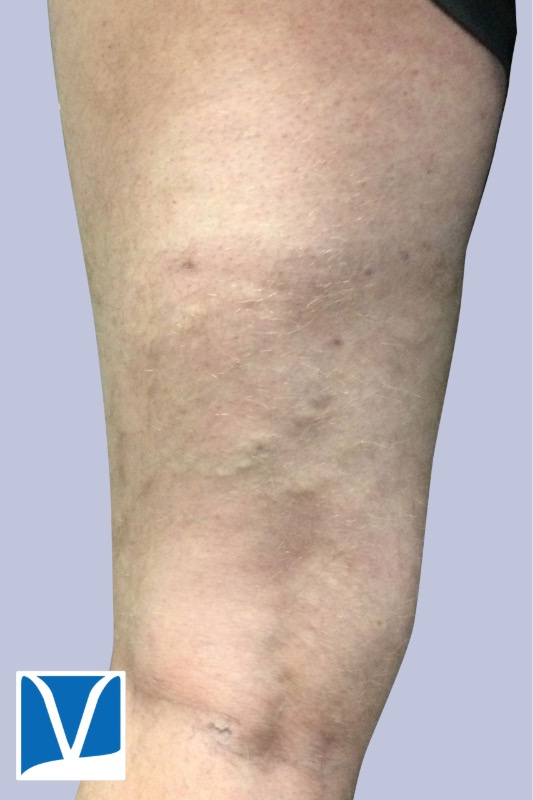Radiofrequency Ablation (RFA) is a vein treatment procedure commonly used for the outpatient, minimally invasive treatment of varicose veins. This technique uses a gentle heat based technique for closing the saphenous veins that contributes to varicose veins in the legs. Its also known by its brand name, Closurefast. This was first developed in late 1990s. It has since taken the place of vein stripping. Our doctors at Inovia Vein Specialty Centers have performed over 4,000 of the procedures over the last decade, with excellent results. Most patients feel its a quick, easy, relatively pain free procedure that allows them to be quickly treated and get back to their usual activities with little down time.
Patient Selection
Closurefast radiofrequency ablation is ideally suited for patients with varicose veins based on the greater saphenous vein (GSV) or small saphenous veins (SSV…formerly called the lesser saphenous vein, or LSV).
Sometimes it is used for major branches such as the anterior accessory saphenous vein (AASV) or posterior accessory saphenous vein (PASV). Finally, this technology can be applied in selected cases for incompetent perforator veins (IPVs). These are superficial veins below the skin but above the muscle that carry blood from the skin and sub cutaneous tissues (below the skin) up to the heart from the legs. These veins have valves that close and open in such a way to prevent blood from pooling in the lower leg veins. However, if these valves become weak, the blood can pool under pressure, leading to varicose vein branches visible on the legs. In advanced cases, this can lead to skin changes on the lower legs (Brown and Red) or venous stasis ulcers.
An ultrasound can be done to map out the veins, and measure their locations and sizes, as well as the degree of venous reflux (or downward pooling of the veins from faulty vein valves). When a patient with signs or symptoms of varicose veins is found to have these issues, and the saphenous veins are found to be dilated with varicose branches, they are a candidate for a Closurefast procedure with the goal of relieving their symptoms and helping reduce the numbers of varicose veins. Sometimes there is just one saphenous vein on one leg that needs to be treated.
Used With Permission | Results May Vary
These Photos Are of an Actual Patient of Our Practice Who Has Provided Consent to Display Their Pictures Online. Keep in Mind That Each Patient is Unique and Results May Not Occur for All Patients. Please Book a Consultation for More Info on How Treatments May Help You.
Sometimes there are more than one vein on both legs. All can be treated, if indicated. In your treatment planning with the physician this can be estimated.
The Procedure
This procedure is done in the office setting at Inovia. Patients walk in, lay down on the table, and their leg is prepped for a quick, outpatient procedure. The patient is awake. Sometimes they choose to take a small amount of Valium in pill form to help reduce anxiety about procedures, but IVs are not started and general, regional or IV sedation is not required. A local anesthetic anesthetizes the skin around the knee and the saphenous vein is accessed.
The RFA catheter is inserted inside of the vein using ultrasound guidance. The catheter is advanced up the dilated vein towards the the upper leg. The catheter is subsequently surrounded by a local anesthetic, called Tumescent anesthesia. This prevents the patient from feeling discomfort during the procedure. The catheter uses a mild degree of heat to treat the inner lining of the vein. However, the patient does not feel the heat due to the local anesthetic. This treatment causes vein shrink down and to be reabsorbed by the body. The patient is assisted to put on a thigh high procedure, and then they can stand up and walk immediately after. Patients often ask what happens to the vein after treatment. The target vein is an abnormal vein that is no longer functioning. After treatment, the vein is reabsorbed by the body and the blood is diverted to healthy veins for return to the heart.
Call 1-800-834-6362 to Schedule a Consultation or Use Our
Recovery after Closurefast
The night after the procedure the patient generally takes it easy. There is no need for bed rest, but we suggest they elevate their leg on a pillow and then get up and walk every hour or so. We advise the patient wear the compression hose the first night until the next morning. The next morning they can remove the hose and shower. They may notice some bruising along where the vein was treated. For discomfort, at first non steroidal anti-inflammatory medications can help (like Advil or Aleve).
In patients who cannot tolerate these medications, Tylenol can help as well. For some patients we prescribe a topical anti-inflammatory, like diclofenac (Voltaren) cream. We advise that patients generally wear compression stockings for one week after this procedure, however, they can usually get back to normal activities quickly. We instruct the patients to watch for increased swelling, pain, redness, fever or chills and to call if there is any concern. On our follow up evaluation we will obtain a venous ultrasound, when indicated, to evaluate the completeness of the venous closure and for any potential complications like DVT, which are rare.
Short and Long Term Results
In the short term, its common to hear that the patient’s leg feels better than it did before the procedure. Patients often comment that they notice less swelling, ache and tiredness. This may be because there is less pooling of blood in the leg now that the saphenous vein is sealed. Those with wounds such as venous stasis ulcers, will often notice that the wounds have healed, and the skin is less brown or red.
Clinical studies show durable closure in over 90% that persists up to 5 years.
In many patients this will be adequate to relieve their symptoms for some time. This procedure is a treatment, however, not a cure. Thus sometimes patients return years later requiring additional treatment.
Insurance Coverage
Many insurance companies pay for the Closurefast procedure in part or in full, depending on the clinical indications. The Closurefast procedure has coverage policies with major health insurers including Medicare. We can help you consult your insurance provider to confirm coverage prior to any planned treatments.
Frequently Asked Questions
Closurefast
In most cases, patients can travel as soon as the day after a Closurefast procedure. However, long-term travel that may restrict leg movement will require additional precautions.
Radiofrequency Ablation is not suitable for all patients. We will perform a venous ultrasound mapping of the varicose veins and can determine what treatment options we have for the patient. In some cases, other options such as Varithena or VenaSeal may be more fitting. We discuss these options with the patient when we do our vein treatment planning, before any procedures.
The night after the procedure we generally advise the patient to go home, put their leg up, and take it easy. They will have a wrap or stocking on their leg, which will be removed the next day. Then the patient can go back to all their usual activities, including exercise. So in most cases, down time from recovery is overnight.
Vein stripping is a very invasive procedure that requires incisions and stitches, which can be painful. Closurefast is done with a small catheter inserted close to the knee, using numbing medicine around the vein and a gentle heat that is used to seal the vein from the inside. There are no incisions that require stitches, and no need for general anesthesia - as Closurefast can be done with local anesthesia. There is very little down time for the patient, with most patients going back to their usual activities the next day. Closurefast has better outcomes, fewer complications, and lower costs compared to vein stripping.
In most cases, Closurefast is performed for what is called medical necessity. Most insurance companies have varicose vein treatment policies and they cover treatments if one meets the medical necessity criteria. Usually this means the patient has symptoms of pain, swelling, ache or itching.
Yes. This is an FDA approved device that has been shown to be far safer in terms of complication risk than the old method of surgical vein stripping. It is not without any risk, however. There is a risk of blood clots, which are usually quite small and easy to manage. There are other risks as well that do not commonly happen. It is best to review the potential risks and benefits with your vein care provider before you have any procedures.
Most patients tolerate the Closurefast procedure very well. We use numbing medicine in the skin and around the vein we are treating, so the patient feels pin pricks in the skin when the numbing medicine is inserted. However, once the vein is numb, there is no pain when the treatment is taking place. After Closurefast, there can be inflammation around the vein while it is healing. Most people find NSAIDs help such as Ibuprofen or Alieve. Also, topical NSAIDs like Voltarin can help.

